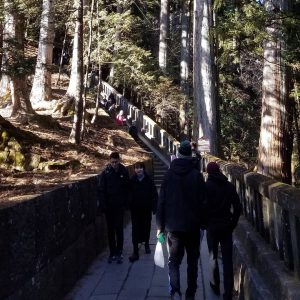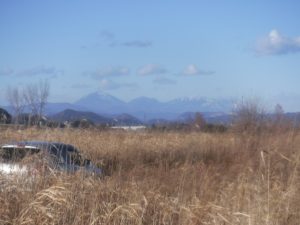Environmental activist and politician Tanaka Shozo was quoted as saying that “the remnants of human life will be destroyed by technological civilization”. This statement reflects a well-justified pessimism of the effects of Japan’s imperial government and rapid industrial development during his years of resistance at the beginning of the 20th century. Given the relative lack of political and economic power held by the common Japanese people, its seems as though they had little chance of successfully appealing for environmental reforms and protections at that time.

The ancient forested staircase leading to the tomb of Emperor Tokugawa Ieyasu, at Nikko.
Following our remarkable trip to Nikko on the 19th, we visited the Watarase Basin on the 21st, situated down the river on the opposite side of the same mountain range. Tanaka, along with the local villagers and farmers, had protested the plan by the Japanese government to establish this basin as a containment area for the pollution being carried downstream from the Ashio copper mine. Copper extraction from the mine had greatly increased at the end of the 19th century, and was used to help fund Japanese colonial expansion. The government had primarily ignored earlier protests concerning the poisonous gases polluted from the mine, which killed the surrounding trees and greatly disturbed farming and human heath; exacerbated further by increases in flooding. This protest was again unsuccessful, as the villagers were forceably displaced from enormous area of the basin. We were told that some of the small hills where their shrines and other buildings used to be could still be seen nearby, but instead we saw the “memorial” where their family gravestones had been relocated: the names of the individuals—all listed together on the back of a Japanese gravestone—had been encased in the cement of the memorial, itself a drab and brutalist structure which offered no space for traditional family gravesite offerings. Even as an outsider being freshly introduced to the culture, the level of disrespect was obvious and made tangible in the structure to an upsetting degree.

The grasses of the Watarase Basin today, some more than 2 Bennett’s tall. Visible are the mountains of Nikko, bare and treeless on this side.
The grasses of the Watarase basin had their own beauty to them today, it must be admitted, but they reminded me of the Midwest prairies back home; something very out of place an unnatural here. Prior groups in this course had been given the opportunity to see the bare mountainside and piles of slag remaining from the Ashio copper mine itself, and a significant part of me wanted to see it as well despite knowing the gloom it would cause, just to know and to feel it in my gut. I think we all thought of the plans to mine copper in the Boundary Waters, which makes the wastes a possible reality near home for us, pulling Ashio into our “backyard”.
Recent Comments